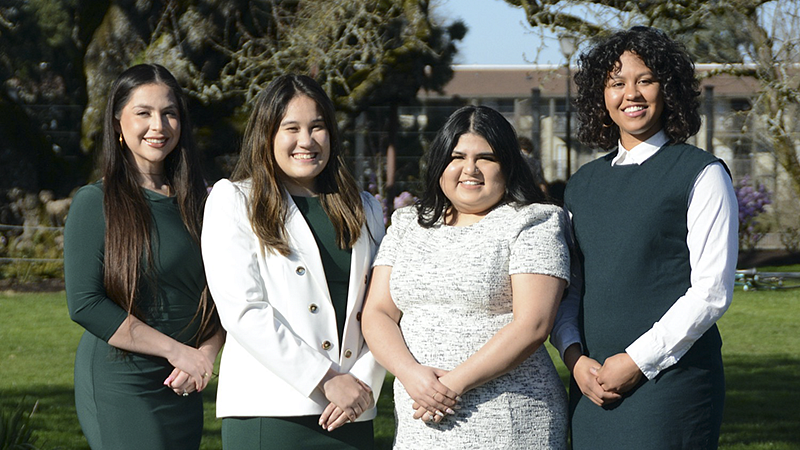This past year, the Associated Students of the University of Oregon (ASUO) Constitution Court has been one of the most diverse in ASUO history.
The Court was made up with students of color entirely. Four of the five justices were women.
Chief Justice Shiwanni Johnson and Associate Justices Diamante Jamison (not pictured, is the lone male), Adria Escobedo, Kaitlyn Lindaman, and Rebeca Lopez-Figueroa made up the student body of the ASUO Constitution Court.
Shiwanni Johnson graduated from Oregon Law in Spring 2021. Diamante Jamison, Adria Escobedo, Kaitlyn Lindaman, and Rebeca Lopez-Figueroa are rising third-year Oregon Law students and plan to graduate in 2022.
These students are a part of different programs that Oregon Law offers.
Johnson is the founder of the Technology and Law Club. Jamison is a legal intern at Energy Trust of Oregon. Escobedo is the Vice President of the LatinX Law Student Association. Lindaman is the Editor in Chief of Volume 100 of the Oregon Law Review. Lopez-Figueroa is a Law Clerk at the Oregon Department of Justice.
All of them came together for the ASUO Constitution Court. The ASUO Constitution Court is a five-member body appointed by the University of Oregon Student Body President and confirmed by Student Senate. Associate Justices serve “lifetime” terms for the duration of their time as UO students. The ASUO Court has the authority to rule on any rule promulgated under it. This review power covers almost any action by ASUO government bodies, programs, and in special cases such as elections, actions by individual students within Student Organizations.
The Court has broad powers to impose sanctions to compel compliance with its rulings.
“My role as an Associate Justice is to uphold the ASUO Constitution,” said Associate Justice Lopez-Figueroa. “When there are issues about rule changes or grievances from the student body, we read them and ultimately make a decision about their constitutionality.”
Reflecting on her role as Chief Justice, Johnson says, “I see my role as leading by example, by creating a community and connection, by leaving a foundation for those who come after, and by being visible.”
Having a diverse court creates visibility, representation, diversity of thought, and a foundation for the future.
“It is important that we are seen,” said Chief Justice Johnson. “We need to be seen leading, succeeding, and thriving.”
Each one of the members of the Court brought a unique perspective that informed the opinions that they drafted.
The work that the Court does involves issues that impact all students. It is necessary to have a diverse court to represent the entirety of the University of Oregon student population.
“I want to ensure our student body that it is our job to represent those who are often overlooked,” said Associate Justice Escobedo. “Fairness will always prevail.”
-----------------------------------------------------------------------------------------------------------------------------------------
By Rhianna Comito, School of Law Communications

